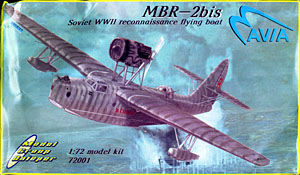Model Group Dneiper's 1/72 MBR-2bis Flying Boat | | History 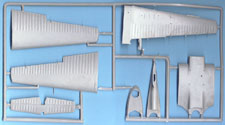 The MBR-2 was an early 1930s product of the TsKB MS, headed by G. M. Beriev. Powered by an M-17 engine in a nacelle above the wing, the first MBR-2 took to the air on May 3, 1932. The design quickly found its way into service and eventually the more powerful M-34 engine was mated to the airframe, resulting in the MBR-2bis. By the time the Second World War rolled around, the MBR-2 was the most numerous flying boat in Soviet service, and it served throughout the conflict, performing SAR and ASW duties. Foreign usage was limited, with only Finland and North Korea operating the type. The MBR-2 was an early 1930s product of the TsKB MS, headed by G. M. Beriev. Powered by an M-17 engine in a nacelle above the wing, the first MBR-2 took to the air on May 3, 1932. The design quickly found its way into service and eventually the more powerful M-34 engine was mated to the airframe, resulting in the MBR-2bis. By the time the Second World War rolled around, the MBR-2 was the most numerous flying boat in Soviet service, and it served throughout the conflict, performing SAR and ASW duties. Foreign usage was limited, with only Finland and North Korea operating the type.
 The Kit The Kit
I believe this is the only injection-molded kit of the MBR-2bis out there, and luckily it's not too bad. The box is a little weak but it still protected the parts pretty well. You get one clear sprue and six colored sprues, as well as a pair of wing lights molded in red and green. The parts are molded in three different colors of plastic. The hull and wing pieces come in a beige plastic, the engine and tailplanes are in white, and the struts &  wing floats are in a translucent white plastic. The latter might be troublesome if it's not the same plastic as the rest of the kit. I'll have to test it out and see, but even if it doesn't respond to regular plastic cement it will have no problem with CA or epoxy. wing floats are in a translucent white plastic. The latter might be troublesome if it's not the same plastic as the rest of the kit. I'll have to test it out and see, but even if it doesn't respond to regular plastic cement it will have no problem with CA or epoxy. The interior is fairly well detailed, with some heavy sidewall detail on the fuselage halves, a cockpit floor and a rear gunner's floor, as well as the usual interior details such as a control yoke, rudder pedals and an instrument panel. A rear turret and machine gun is also provided, rounding out the interior. 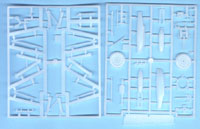 While some of the detailing seems a bit heavy, the limited openings will hide much of this, and once painted and suitably weathered it should look just fine. While some of the detailing seems a bit heavy, the limited openings will hide much of this, and once painted and suitably weathered it should look just fine. The rest of the assembly is pretty straightforward, with the biggest challenge being all of the struts. The engine nacelle has quite a few parts, but should go together well. There's a couple of options for the exhaust stubs, depending on the version. The wings have a center section and split upper & lower outer sections. A spar might be useful here to keep things in alignment, as the outer 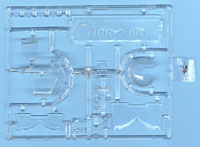 panels are butt-joined to the center section & fuselage. The tailplane assembly is added to the fuselage, and the final step would be adding the wing floats. Beaching gear is also provided. panels are butt-joined to the center section & fuselage. The tailplane assembly is added to the fuselage, and the final step would be adding the wing floats. Beaching gear is also provided. The decal sheet in this kit is somewhat small, especially considering how many options are actually presented. A total of 14 different schemes are present, including four Finnish, one North Korean, and nine Soviet examples. Some are plain, others are weatherbeaten, and there's even one with an interesting wave pattern painted on it. The decals themselves look good, although the blue seems a bit light to my eye. They feel thin and have a flat finish to them. How they perform remains to be seen, but the flat surfaces of the plane should make things a bit easier. 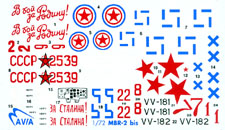 Conclusion Conclusion
Considering that this was the main flying boat of the Soviet Air Force in World War Two, it's surprising that not more has been written on the plane. This kit is a welcome addition to any VVS collection and the interesting markings and camouflage schemes included in the kit will guarantee some fun modeling ahead. | 


 



  
   |
